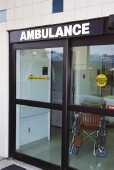Off-Hours Heart Patients Less Likely to Get Angioplasty
But study also finds survival rates similar, no matter when admission occurred.
|
E-mail this article
Subscribe to news
Printer friendly version
|

(SOURCE: American Heart Association, news release, April 21, 2008)
MONDAY, April 21 (HealthDay News) -- Compared to heart attack patients who arrive at hospitals during weeknights, weekends and holidays, those who arrive during regular hours tend to receive faster and more comprehensive care, says a U.S. study.
However, those differences don't affect in-hospital death rates of heart attack patients, said the authors of the study, which was published in the April 22 issue of Circulation.
Of the 62,814 heart attack patients included in the study, 54 percent arrived during off-hours. They were 7 percent less likely than patients who arrived during regular hours to undergo primary percutaneous coronary intervention (PCI) and 6 percent less likely to undergo PCI or another type of revascularization called coronary artery bypass graft (CABG).
"Emergency angioplasty, or PCI, is the preferred procedure after an ST-segment elevation myocardial infarction, which is a heart attack caused by a completely blocked artery," study author Dr. Hani Jneid, an interventional cardiology physician-in-training at the Massachusetts General Hospital in Boston, said in a prepared statement.
"The goal of PCI is to open the artery as soon as possible, and preferably within 90 minutes of the patient arriving at the emergency room," Jneid said. "In our study, the average time from when the patient entered the hospital to when he or she received the procedure was 110 minutes during off-hours compared with 85 minutes during regular hours."
Jneid and colleagues also found that patients who arrived in off-hours were 66 percent less likely to achieve the 90-minute window for primary angioplasty recommended by the American Heart Association and the American College of Cardiology.
Despite the differences, death rates were similar for both groups of patients -- 7.1 percent for patients arriving during off-hours and 7.2 percent for those arriving during regular hours.
"It is interesting to note that the observed delays in primary PCI did not translate into measurable differences in in-hospital outcome," Jneid said. "This seems to run counter to previous study findings. Future studies should not only strive to confirm or disprove these results but also examine variables that might affect the interplay of care and outcome with arrival time."
More information
The American Heart Association has more about heart attack treatments. 
: 
HealthDayNews articles are derived from various sources and do not reflect federal policy. healthfinder.gov does not endorse opinions, products, or services that may appear in news stories. For more information on health topics in the news, visit the healthfinder.gov health library.